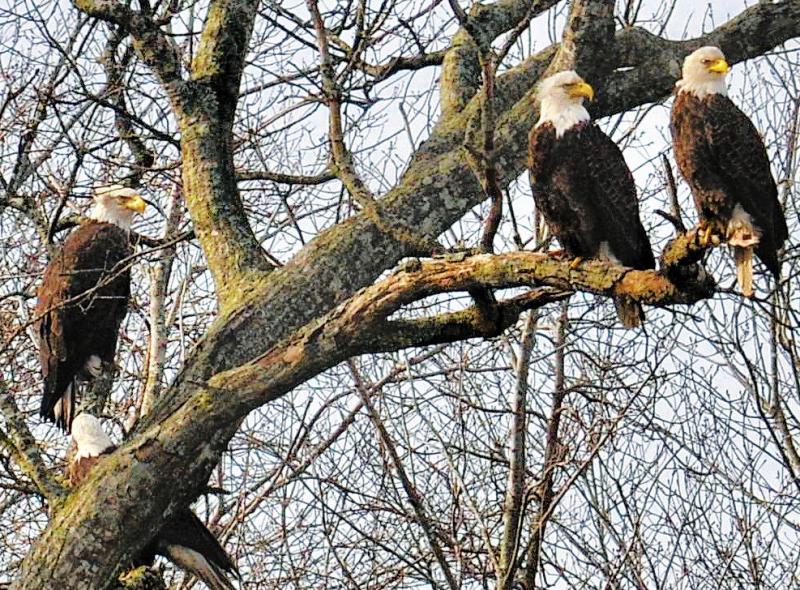A convocation of eagles conjures up solemn stories
Seeing Ron MacArthur’s photo of six mature bald eagles in one Sussex County tree near Georgetown last week made me want to know more. Ron was called by a reader who knew he would be interested. As it turns out, the six in the photo on the front page of the Cape Gazette were just a quarter of the 25 that Ron counted in those trees and the field nearby.
Ron reported that a large group of bald eagles like that is known as a convocation. They do look like a solemn and religious bunch, but I could find no particular reason why that term has taken hold to describe groups of bald eagles.
Annie Larsen, wildlife biologist at Prime Hook National Wildlife Refuge, said this is the time of year when we see peak numbers of bald eagles in Sussex County. With Valentine’s Day approaching rapidly, it’s not just people in the mood for love at this time of year. “The young get together about now looking for mates,” she said. “Looking for love. They’re trying to figure out who they will pair up with. Sizing each other up. Sitting among each other, preening. And with all the snow geese around, there’s plenty of food for them here as well.”
Larsen said it’s not unusual for 10 or 20 bald eagles to be hanging around the refuge at this time of year. After performing visual acrobatics including flying high in the sky together then locking talons as they cartwheel and somersault toward the earth, pairs eventually mate and then take to the nest in February. According to information gleaned from the internet, bald eagles are among a number of species of birds that mate for life. They can live up to 30 years.
Larsen said there used to be three nesting pairs of bald eagles at Prime Hook. “But then the biggest male we had was electrocuted one day when he landed with a dead fish on a power line. It was in the Island Farm area [east of Route 16 near Broadkill Beach.] The fish was wet and the two of them died and stuck to the wires. It was sad. We had to get a bucket truck to get them down.”
Larsen said when bald eagles die of natural causes, or accidentally, on federal lands they have to be sent to the National Eagle Repository in Commerce, Colorado. “There they are made available to recognized Native American tribes who use them to make fans, whistles, and other objects used in religious ceremonies. They’re the only people allowed to use parts of bald eagles. And they use every part: feathers, talons, beaks - everything.”
She noted that ever since bald eagles went nearly extinct due to DDT pollution that thinned their eggs in the 1970s, eagles have made a nice comeback. One source indicated that due to the ravages of DDT, the total number of nesting pairs of bald eagles in the U.S. dwindled to 450 in the mid-1970s. After DDT use was outlawed, the rebound began quickly. By 2004, some surveys speculated that nesting repairs had increased to more than 10,000.
Bald eagles have seven-foot wingspans and build very large nests, often in dead trees, where they raise their young. Some of their nests have been measured at more than six feet in diameter and weighing as much as 4,000 pounds. They eat fish, often diving on ospreys to take their catches. They also eat dead deer, ducks and other warm-blooded creatures.
When Cape Gazette Editor Trish Vernon traveled to the Canadian city of Victoria recently, a tour of the city made a stop at the base of a tree with a huge eagle’s nest above a street and sidewalk. The guide told her group that workers have to get up in the nest from time to time to take out heavy pieces of wood that they fear might fall on pedestrians below.
“They told us that one time when they were taking out some of the dangerously large sticks,” said Trish, “they found several plastic cat collars.” Bald eagles, with their razor-sharp talons, can lift up to four pounds with little difficulty.
And now a prayer, from the convocation, for lost souls.
















































